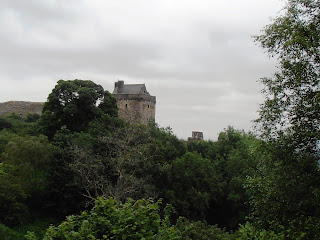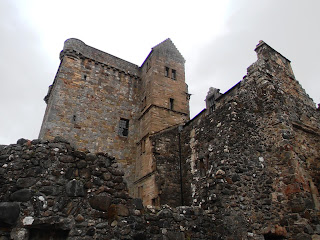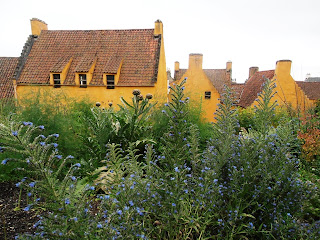25 July 2017:- The
itinerary was mine but more complicated than we finally undertook; my husband
is a better time manager than I, or at least better at understanding how much
can realistically be squeezed into one day. And even then, we were pushed to
fit the abbreviated schedule in before home time.
Today was
to be the last fine day while based near Saline, so it was better to be spent
on a tiki tour rather than a “city” style agenda, so we headed off to Dollar,
only about five miles to the north. This was to be the first of several urban
settlements seen today that we found most pleasing to the eye, contrary to my
scathing remarks of previous days.
 We headed
up into the Ochil Hills beyond the small town, into the steep ravine of Dollar
Glen to visit Castle Campbell aka Castle Gloom. At the end of the narrow road
one and a half miles above the town, we reached a car park then set off on foot
for the last half mile or so to the castle itself. On either side of the
striking remains, flow the Burns of Care and Sorrow, down into the Dollar Burn.
Doesn’t that capture the imagination!?
We headed
up into the Ochil Hills beyond the small town, into the steep ravine of Dollar
Glen to visit Castle Campbell aka Castle Gloom. At the end of the narrow road
one and a half miles above the town, we reached a car park then set off on foot
for the last half mile or so to the castle itself. On either side of the
striking remains, flow the Burns of Care and Sorrow, down into the Dollar Burn.
Doesn’t that capture the imagination!?
The castle
was built as a demonstration of the wealth and power of the Campbell family of
Argyll, who used it as their lowland home until 1654. The Campbells were one of
the most successful dynasties in Scottish history, first rising to prominence
in the 1300s.
Archibald, 8th earl of Argyll, was high in the favour of Charles I and was elevated to the rank of marquis in 1641. Following the execution of the king, it was Argyll who placed the crown on the head of Charles II at Scone in 1651. However he later came to support Cromwell and the Commonwealth and Castle Campbell was used as a base by English troops. It was in retaliation for this that the castle was burnt in 1653. Argyll was executed for disloyalty in 1661 after Charles II had been restored to the throne.
Archibald, 8th earl of Argyll, was high in the favour of Charles I and was elevated to the rank of marquis in 1641. Following the execution of the king, it was Argyll who placed the crown on the head of Charles II at Scone in 1651. However he later came to support Cromwell and the Commonwealth and Castle Campbell was used as a base by English troops. It was in retaliation for this that the castle was burnt in 1653. Argyll was executed for disloyalty in 1661 after Charles II had been restored to the throne.
 The family
was further elevated in 1701 to a dukedom but by then Castle Campbell was a
ruin, and was no longer liveable as a family residence. The decision was taken
to sell the castle in about 1810, when the 6th Duke’s finances were
already heavily over-stretched by his decision to build a grand new house on
the north bank of the Firth. The Campbell connection with the castle was thus ended
but the name remains.
The family
was further elevated in 1701 to a dukedom but by then Castle Campbell was a
ruin, and was no longer liveable as a family residence. The decision was taken
to sell the castle in about 1810, when the 6th Duke’s finances were
already heavily over-stretched by his decision to build a grand new house on
the north bank of the Firth. The Campbell connection with the castle was thus ended
but the name remains.
There had
been some sort of structure here before the Campbells arrived although the
details are sketchy, however the initial tower house was completed in about
1470. The Hall and Chamber Range which were subsequently burnt down, were added
to about 1500, and the east range which ended similarly, was added or
remodelled about one hundred years later.
 Certainly
by the time that Glasgow businessman Sir Andrew Orr bought the property in
1859, the castle had fallen into serious disrepair. His son, James, carried out
major repairs in the late 1870s. Much later, in 1948, the then owners gave
Dollar Glen to the National Trust for Scotland, who arranged for the castle to
be cared for by the Ministry of Works. Restoration works have included a new
roof on the tower, and excavations in the 1980s revealed charred timbers from
the 1654 burning. The castle is now managed by Historic Scotland.
Certainly
by the time that Glasgow businessman Sir Andrew Orr bought the property in
1859, the castle had fallen into serious disrepair. His son, James, carried out
major repairs in the late 1870s. Much later, in 1948, the then owners gave
Dollar Glen to the National Trust for Scotland, who arranged for the castle to
be cared for by the Ministry of Works. Restoration works have included a new
roof on the tower, and excavations in the 1980s revealed charred timbers from
the 1654 burning. The castle is now managed by Historic Scotland.
Even in
its semi-ruined state, it is indeed a solid structure and we were able to climb
the spiral staircase of the tower onto the roof to enjoy stunning views down
over Dollar, over the resurrected gardens and beyond, even to the fuzzy outline
of the new Forth Bridge yet to be completed.
After
spending some time chatting with the guide at the entrance gate, on matters
pertaining to this Castle, our dilemma of destinations to the north and other
matters, we wandered all about, then took a path through the woods to see the
waterfall we could hear roaring down into glen. Alas the actual path of the
water was camouflaged behind a screen of vegetation, but we agreed that it was
wonderful to be walking in steep bush land very like that “back home”.
From
Dollar, we travelled westward up Glen Devon on the B823, over a pass on the
Ochil Hills, then down Glen Eagles, that which gives its name to the famous
golf course. As we followed the River Devon toward its source, we pulled into the
Glen Devon Woodlands Park, or more particularly that part about the Glen Sherup
reservoir. There are walking tracks all the way down the Glen linking up the five
reservoirs, the Glen Sherup the middle one situated between Ben Shee and
Innerdownie. We had seen a “Beware of Red Squirrels” sign and I thought we
might do a bit of squirrel spotting given my great success at spotting wild
koalas in Australia.
We set off
into the forest on foot up a service track and passed by a house where a woman was tending her
garden. We called out greetings and asked if there were red squirrels
hereabout, to which she replied that yes, indeed there were. They were often
seen scampering along the garden wall in front of her kitchen window. She also
told us that if we continued on for a further half mile, we would have views of
the loch and were likely to spot birds of prey swooping about the skyline. It
was a long half mile, but then a mile is longer than a kilometre and an uphill
mile is longer still. While the view was lovely, we spotted a couple of field
mice but nothing more. She had mentioned fishermen out on the lake, but we were
still surprised to see about four identical little craft each bearing a
fly-fisherman.
Back down
in the car park we picnicked before pressing on through the picturesque
countryside, turning south onto the A9 toward Dunblane, travelling down the
wide valley of Allan Water, Strathallan (“strath” being the Scottish word for “wide
valley”).
 Dunblane proved
to be yet another attractive town, best
known as the hometown of the tennis playing Murray brothers and more infamously
for a mass shooting of schoolchildren and their teacher way back in 1996. It
was the tennis connection that I brought to Chris’s attention when suggesting
that we call into the town.
Dunblane proved
to be yet another attractive town, best
known as the hometown of the tennis playing Murray brothers and more infamously
for a mass shooting of schoolchildren and their teacher way back in 1996. It
was the tennis connection that I brought to Chris’s attention when suggesting
that we call into the town.
The
Cathedral, still known as such only because it was once, before the Reformation,
a place of bishops, dates mainly from the 13th century, although has
a rather on and off architectural history. When England’s Edward I came north
to wipe out the northern competition just after the first version of the
cathedral was completed, he demanded that the lead be stripped off the roof for
melting down and providing shot weights for his massive trebuchet with which he
blasted nearby Stirling Castle.
When we
arrived we found the church closed for an hour, which we later decided was so
that the Heritage Scotland guide could break for lunch and a comfort stop. We
spent the interim in the little museum opposite and learned a little more about
Dunblane. Here can be found a 4,000 year old necklace found in archaeological
digs nearby, older than the Egyptian pyramids!
We were
glad to have stopped by Dunblane, but were also aware that the afternoon was
half gone by the time we had checked out Allan Water and the High Street where
we bought the day’s newspaper. Our next destination was Culross (pronounced
Cooros) on the northern bank of the Firth, beside the Longannet Power Station
and opposite the Grangemouth Refinery, neither particularly complimentary to
scenic tourist destinations.
Had I been
left to the navigation myself, I would have had us travel via Clachmannan down
the eastern side of the River Forth, however our Tomtom considered it more
efficient to travel via the major motorway system, south to the west of
Stirling then across the Kincardine Bridge. It was about 3pm when we finally
parked on the shore on the edge of Culross.
 Culross is
the best preserved 17th century in Scotland, having started its life
as a Cistercian Abbey, established in 1217, and its future was guaranteed with
its reputation as a source of coal. The monks, or their minions, scraped as
much of the black gold as they could but gave up when their pits continued to
fill with the waters of the Forth.
Culross is
the best preserved 17th century in Scotland, having started its life
as a Cistercian Abbey, established in 1217, and its future was guaranteed with
its reputation as a source of coal. The monks, or their minions, scraped as
much of the black gold as they could but gave up when their pits continued to
fill with the waters of the Forth.
George
Bruce arrived in the town in the 16th century ready and modernised
the extraction of the coal, by using an early form of pump, thus allowing coal
to be mined from under the firth. With the extracted coal, he had a successful
industry turning seawater in to salt for preserving and the dinner table. In
time, after obtaining a royal licence to do so, both salt and coal were
exported and exotic imports arrived to add to his manna, further added to by
the title, Sir George Bruce.
And such a
fine gentleman required an equally fine dwelling place, and so the “Palace” of
Culross was built and later added to. It is a grand house and well decorated in
the style of its heyday, these days managed by the National Trust of Scotland
as is most of the town. The painted and panelled rooms and stunning walled and
terraced gardens are two of the most impressive features, or at least were for
us.
The
National Trust for Scotland was set up in 1931 to preserve threatened buildings
and places of natural beauty for the benefit of the nation; Culross Palace was
the first property the National Trust for Scotland bought in 1931 for £700. It
was then given over to the State for safekeeping until 1991, when it was handed
back to the Trust’s care.
We walked
up to the top of the town to visit the Abbey Ruins; not a lot to see here but
reached via cobbled narrow streets full of charmingly appointed period houses.
Needless to say the abbey went the way of most such institutions with the
arrival of the Reformation of 1560. The parish church attached to the ruins is
still in operation, as a rather plain Presbyterian place of worship and also
the resting place for Sir George Bruce and his wife.
By the
time we arrived back at camp, it was after 5 pm, and tomorrow’s forecasted rain
is already standing by to complicate our last full touring day in the Kingdom
of Fife.








No comments:
Post a Comment